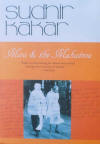|
|
the-south-asian.com December 2004 |
|
|||
|
December
2004 Performing Arts
Architecture Books Between
Heaven and Hell
|
|
||||
|
SUDHIR KAKKAR - Exploring a complex relationship by Shruti Sethia
Mira And The Mahatma (Penguin) is a
semi-fictional account of the complex relationship between Mahatma Gandhi
and Madeline Slade, the daughter of a British admiral---whom he
re-christened Mira…. It is 1925 and India's struggle for freedom is in utter
disarray - impeded by factionalism among its leaders and rising incidents of
communal disharmony across the country. Mahatma is a perturbed man. Having withdrawn himself from
active politics, he is in the Sabarmati Ashram in Gujarat, immersed in what
he considers the most important undertaking of his life - the creation of an
ideal community guided by the highest standards of self discipline,
tolerance and austerity. Mira And The Mahatma (Penguin) is a semi-fictional
account of the relationship between Mahatma Gandhi and Madeline Slade, the
daughter of a British admiral. Madeline became Mahatma’s disciple and thus
begans an extraordinary association between two individuals driven by
distinct passions. For Gandhi true spirituality lies in self-rule, a mastery of
self that liberates the being from all forms of craving, physical and
emotional and total dedication to practical work in service of society. Madeline believes that the path to ultimate truth is the
complete surrender to a human embodiment of the Eternal Spirit - and that
for her is Gandhi himself. This explains why Gandhi re-christens Madeline as
Mira - after the Rajasthan princess, who abandoned everything in the pursuit
of spiritual love for Govind. Complex Relationship In his bold fictionalized exploration of this complex
relationship, Sudhir Kakkar displays his skills at handling delicate
material with remarkable sensitivity, instinctive empathy and high
imagination. The writer took three and half years in writing and researching
the book which is also being translated in German, French and Italian. A psychoanalyst and writer, Goa-based Kakkar’s critically
acclaimed earlier novels, The Ascetic Desire and Ecstasy, also
published by Penguin in India have been translated into several languages
around the world. He admits that the book may stir some controversy but that
has not been his intention. "It is sourced from actual letters exchanged
between Mira and Gandhi," says the author. Kakkar strongly refutes the charge that he has harmed the
image of the Mahatma. He observes that he has not brought out anything new.
He has only brought into open something that was lying in the back burner
for so many years. "There are no ‘revelations’ for anyone who is familiar
with Gandhi’s own writings. In his own writings he reveals more about
himself than any writer can ever do," says Kakkar. The author adds, "For great men and women, the distinction
between private and public life collapses. Our curiosity about their lives
is much greater than our interest in what they have preached or stand for.
Gandhi himself did not believe in the personal and public distinction. The
book only brings him closer to all of us and encourages us to again engage
with him instead of seeing him as a distant, iconic figure." Mira who spent nine years with Gandhi retired to the
Himalayas in 1934 and finally left India in 1958. She died in Austria in
1982 where she lived an austere life of a recluse in a house that was a
near-replica of the Sabarmati Ashram. Kakkar's expositions appear more aimed at entertaining the
reader rather than providing information that can be substantiated by
history. Since it is more fiction, the author has felt free to juggle facts.
"It is only the informed and broad-minded reader who will
enjoy reading the book," says Kakkar aware of the fact that the book will
engage the reader more for its sensual appeal than its historical relevance. *****
|
|||||
|
Copyright © 2000 - 2004 [the-south-asian.com]. Intellectual Property. All rights reserved. |
|||||
